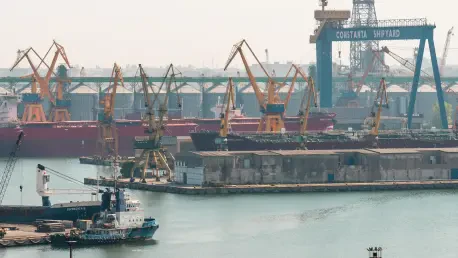Today, we’re thrilled to sit down with Christopher Hailstone, a seasoned expert in energy management and utilities, with a deep understanding of global energy markets and the intricate logistics of oil exports. With his extensive background in renewable energy and grid reliability, Christopher brings a unique perspective to the challenges facing Russia’s oil export infrastructure, particularly at the critical Black Sea port of Novorossiisk. In this interview, we’ll explore the unprecedented pressures on this key hub, from record export levels and capacity constraints to external disruptions like storms and drone attacks, and what these mean for the future of Russia’s energy strategy.
Can you walk us through the current situation at the Novorossiisk port and why it’s under so much strain with oil exports?
Certainly, Silvia. Novorossiisk, a major Black Sea port for Russia, is currently operating at its absolute limit for oil exports. We’re seeing a perfect storm of factors here: record export volumes, limited infrastructure capacity, and external pressures. Last month, exports hit a staggering 0.8 million barrels per day through this port alone, the highest in at least five years. This strain comes from Russia’s inability to refine much of its crude domestically due to refinery issues, combined with increased production quotas from OPEC+ agreements. Traders are scrambling to find alternative routes, but the port simply can’t handle more volume right now.
How did Russia’s oil exports reach such a record high last month, and what’s driving this surge?
The record exports of 2.5 million barrels per day last month are largely a result of significant disruptions in domestic refining capacity. Russia underwent extensive refinery maintenance in August and September, and on top of that, Ukrainian drone attacks have damaged key facilities. When you can’t process crude at home, the only option is to export it. So, the combination of planned outages and unexpected damage forced a massive push of crude oil onto the international market, much of it flowing through Novorossiisk.
With exports through Novorossiisk hitting 0.8 million barrels per day, what does this figure reveal about Russia’s export trends?
That number is a clear indicator of how critical Novorossiisk has become to Russia’s export strategy. It’s the highest level we’ve seen in at least five years, showing a heavy reliance on this Black Sea hub as other markets, like pipeline deliveries to Europe, have dwindled since 2022. Looking at October’s preliminary plan, we’re expecting shipments to hover around 0.73 million barrels per day, which suggests this high level isn’t a one-off. It’s likely sustained by ongoing refinery limitations and the need to keep export revenue flowing despite domestic challenges.
The Transneft pipeline system is reportedly at full capacity. How is this impacting Russia’s ability to manage its oil exports?
The Transneft system, which feeds into ports like Novorossiisk, is essentially maxed out with virtually no spare capacity. This creates a significant bottleneck for Russia’s export strategy because there’s no wiggle room to handle increased production or reroute shipments efficiently. Right now, Transneft is juggling to maintain flow, but without infrastructure upgrades or new pipelines, this constraint could limit Russia’s ability to capitalize on higher production quotas long-term. It’s a structural issue that’s hard to fix quickly.
Let’s dive into the external disruptions. How have drone attacks and other incidents affected Russia’s oil infrastructure recently?
These attacks have been a major headache for Russia’s oil sector. Ukrainian drone and unmanned boat strikes have targeted not just refineries but also key export infrastructure, including Black Sea and Baltic ports, and even parts of the Transneft pipeline network. The damage has reduced domestic refining capacity, forcing more crude to be exported, while also creating logistical headaches at facilities. Over the coming months, these disruptions could lead to unpredictable export schedules as repairs and security measures take priority.
Storms are another challenge for Novorossiisk. Can you explain how weather impacts oil loadings at this port?
Absolutely. Novorossiisk is particularly vulnerable to weather, especially as storm season approaches in the Black Sea region. Storms can halt loadings for days, disrupting schedules and creating backlogs. These delays aren’t rare—they happen frequently during certain times of the year, and when they do, ships are stuck waiting, which throws off export timelines. The ripple effect can be significant, impacting traders and buyers who rely on consistent delivery.
Delays at the Turkish straits are also adding to the complications. Why are these bottlenecks such a big issue for Russian oil exports?
The Turkish straits are a critical chokepoint for Russian oil heading to international markets from the Black Sea. Delays there—often due to heavy traffic, weather, or regulatory checks—slow down the entire export chain. For Russia, which is increasingly dependent on seaborne exports after losing some pipeline customers in Europe, any holdup at the straits means delayed revenue and potential penalties with buyers. It’s a logistical nightmare that compounds the pressure on ports like Novorossiisk.
Looking ahead, what’s your forecast for Russia’s oil export challenges through Novorossiisk and beyond?
I think we’re looking at a sustained period of tension for Russia’s export infrastructure. Novorossiisk will likely remain at or near capacity for the foreseeable future, especially if refinery issues persist and drone attacks continue. Weather disruptions and straits delays are seasonal but predictable hurdles that could worsen the situation. On a broader level, unless there’s significant investment in pipeline capacity or alternative export routes, Russia risks losing flexibility in how it manages its crude on the global market. It’s a tightrope walk, and any additional disruption could have outsized impacts.









